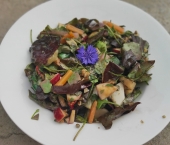
 5
5








Paul Steer wrote:This year, I've had success growing a wheelbarrow full of a light grey-skinned squash variety named Crown Prince.
Last Sunday, in anticipation of a frost which didn't arrive, I picked the lot of them and roasted one in the oven after first removing its seeds.
I quickly rinsed and patted dry the seeds and left them to dry for a couple of days in a wire mesh strainer. This morning, after re-stoking the dehydrator with 1/4" tomato slices, I decided to roast the seeds. It was slam-dunk easy.
First, I pre-heated the oven to 275 degrees and prepped a cookie sheet with parchment paper.
Next, I measured the seeds. I had about 1 3/4 cups.
I then added about 1/2 a tablespoon of Sesame Seed oil instead of the 1 Tbsp. of Olive Oil mentioned in the recipe.
I also cut out the salt the recipe asked for and instead added about 1 Tbsp. of Club House "Tex-Mex" spice blend.
I roasted the seeds for the 20 minutes called for in the recipe, but ended up roasting them in the oven about twice that amount of time because the seeds were so fresh and damp. I figured, correctly, as it turned out, that the seeds would appreciate having the extra roasting time in the oven.
They turned out well, but I'm sure others have better recipes than the one I improvised this morning.
What have been your most successful seed-roasting recipes? I'd sure like to know.
 1
1




Always be kind to animal, plant, and earth.




Invasive plants are Earth's way of insisting we notice her medicines. Stephen Herrod Buhner
Everyone learns what works by learning what doesn't work. Stephen Herrod Buhner
 1
1




 2
2




Weeds are just plants with enough surplus will to live to withstand normal levels of gardening!--Alexandra Petri




greg mosser wrote:i always ate them seedcoat and all. a lot of chewing, sometimes! extra fiber. was it just the texture you didn’t like?
also, thickness of the seedcoat varies some by species. a pepo pumpkin has much thinner seedcoat than a maxima one..
 1
1




 1
1




Anne Miller wrote:Years ago, I read about eating pumpkin seeds so when we had a Halloween pumpkin, I carefully saved and clean the seeds and cooked them as a recipe said, I had never eaten them before so I didn't know what they taste like.
The ones I roasted were horrible. I just could not figure out why people would eat something like that.
This year I read on another thread that the outer layer is peeled off to reveal the "seed". If that is the case why do recipes not say to peel the seeds?




Paul Steer wrote:This year, I've had success growing a wheelbarrow full of a light grey-skinned squash variety named Crown Prince.
Last Sunday, in anticipation of a frost which didn't arrive, I picked the lot of them
Julie Wolf
Growing in a NW Forest - Clearcut Garden http://organicfoodbliss.com/my-clear-cut-garden/ / Northwest Permaculture Convergence http://www.northwestpermaculture.org/ - see my Directory Listing (Mason County).








Telling me it can't be done is my biggest motivation to making it happen.












Telling me it can't be done is my biggest motivation to making it happen.

|
Pay attention! Tiny ad!
Back the BEL - Invest in the Permaculture Bootcamp
https://permies.com/w/bel-fundraiser
|



